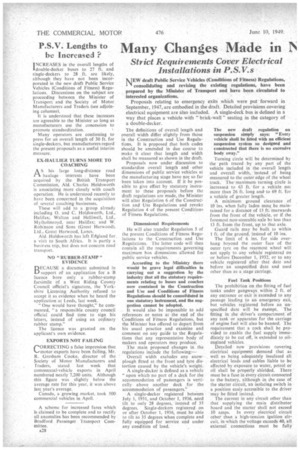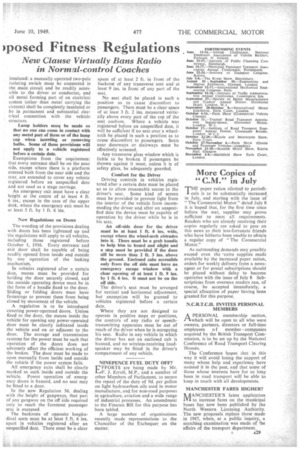Many Changes Made in IS posed Fitness Regulations.
Page 4

Page 5

If you've noticed an error in this article please click here to report it so we can fix it.
Strict Requirements Cover Electrical Installations in P.S.V.s New Clause Virtually Bans Radio in Normal-control Coaches
NEW draft Public Service Vehicles (Conditions of Fitness) Regulations, consolidating and revising the existing regulations, have been prepared by the Minister of Transport and have been circulated to interested organizations.
Proposals relating to emergency exits which were put forward in September, 1947, are embodied in the draft. Detailed provisions covering electrical equipment are also included. A single-deck bus is defined in a way that places a vehicle with " brick-wall " seating in the category of a double-decker.
The definitions of overall length and overall width differ slightly from those in the Construction and Use Regulations. It is proposed that both codes should be amended in due course to make it clear that length and width shall be measured as shown in the draft.
Proposals now under discussion to standardize overall length and other dimensions of public service vehicles at the manufacturing stage have not so far been taken into account. If it be possible to give effect by statutory instrument to these proposals before the draft regulations are made, the Minister will alter Regulation 6 of the Construction and Use Regulations and revoke Regulation 4 of the present Conditions of Fitness Regulations.
Dimensional Requirements He will also transfer Regulation 5 of the present Conditions of Fitness Regulations to the Construction and Use Regulations. The latter code will then contain all the requirements governing maximum box dimensions alloWed for public service vehicles. •
According to the Ministry there would be grave legal difficulties in carrying out a suggestion by the industry that all the statutory requirements relating to buses and coaches now contained in the Construction and Use and Conditions of Fitness Regulations should be consolidated in one statutory instrument, and the suggestion cannot be adopted.
It would also be impossible to add references or notes at the end of the Conditions of Fitness Regulations, but the Minister has offered to depart from his usual practice and examine and comment on any guide to the Regulations that any representative body of makers and operators may produce.
The main proposed changes in the regulations include the following:— Overall width excludes any snowplough fitted at the front and tyre distortion caused by the vehicle's weight.
A single-decker is defined as a vehicle "upon which no part of a deck for the accommodation of passengers is vertically above another deck for the accommodation of passengers."
A single-decker registered between July 1, 1931, and October 1, 1936, need tilt to only 28 degrees, instead of 35 degrees. Single-deckers registered on or after October 1, 1936, must be able to tilt to 35 degrees when complete and fully equipped for service and tinder any condition of load. The new draft regulation on suspension simply says: "Every vehicle shall be fitted with an efficient suspension system so designed and constructed that there is no excessive body sway."
Turning circle will be determined by the path traced by any part of the vehicle included in the overall length and overall width, instead of being measured to the outer edge of the wheel track. The maximum turning circle is increased to 63 ft. for a vehicle not more than 26 ft. long andto 69 ft. for a vehicle of greater length.
A minimum ground clearance of 10 ins, when fully laden must be maintained for a distance of 13 ft. rearwards from the front of the vehicle, or if the foremost non-steerable axle be less than 13 ft. from the front, up to that axle.
Guard rails may be built to within 1 ft. of the ground, instead of 10 ins.
The limit of 6 ins, for side overhang beyond the outer face of the outer tyre on the rearmost wheel will not apply to any vehicleregistered on or before December 1, 1932, or to any vehicle registered after that date and before an unspecified date and used other than as a stage carriage,
Fuel Tank Positions
The prohibition on the fitting of fuel tanks under gangways within 2 ft. of any entrance or exit is extended to any passage leading to an emergency exit, but vehicles registered before an unspecified date will be exempt. The fitting in the driver's compartment of any tank or apparatus for the carriage of engine fuel will also be banned. The requirement that a cock shall be provided to enable the fuel supply immediately to be cut off, is extended to oilengined vehicles.
Detailed new provisions covering electrical equipment demand that as well as being adequately insulated all electrical leads and cables liable to be affected by exposure to water, petrol or oil shall be properly shielded. There must be a fuse in every circuit connected to the battery, although in the case of the starter circuit, an isolating switch in a position easly accessible to the driver may be fitted instead.
The current in any circuit other than that supplying the main distributor hoard arid the starter shall not exceed
10 amps, In every electrical circuit other than a high-tension ignition circuit, in•which the voltage exceeds 40, all external connections must be fully insulated: a manually operated two-pole isolating switch must be connected in the, main circuit and be readily accessible to the driver or conductor, and all metal forming part of an electrical system (other than metal carrying the current) shall be completely insulated or be in permanent and substantial electrical connection with the vehicle structure,
Lamp holders must be made so that no one can come in contact with any metal part of them or of the lamp cap when inserting or removing bulbs. Some of these provisions will not apply to a vehicle registered before a certain date.
Exemptions from the requirement that every entrance shall be on the near side, except where there is a platform entered both from the near side and the rear, are extended to cover any vehicle registered before an unspecified date and not used as a stage carriage.
An emergency exit must have a clear height at the centre of at least 4 ft. 6 ins., except in the case of the upper deck, where the emergency exit must be at least 5 ft. by 1 ft. 6 ins.
New Regulations on Doors The wording of the provisions dealing with doors has been tightened up and 'the regulations will apply to all vehicles, including those registered before October 1, 1936. Every entrance and exit door shall be capable of being readily opened from inside and outside by one operation of the locking mechanism.
In vehicles registered after a certain date, means must be provided for holding the door securely closed, and the outside operating device must be in the form of a handle fixed to the door. Sliding or folding doors must have fastenings to prevent them from being closed by movement of the vehicle.
A regulation is to be introduced covering power-operated doors. Unless fixed to the door, the means inside the vehicle for opening any power-operated door must be clearly indicated inside the vehicle and on or adjacent to the door. The storage and transmission systems for the power must be such that operation of the doors does not adversely affect the efficient working of the brakes. The door must be made to open manually from inside and outside the vehicle if the power system fails.
All emergency exits shall be clearly marked as such inside and outside the vehicle. Power operation of emergency doors is banned, and no seat may be fitted to a door.
In the new Regulation 36, dealing with the height of gangways. that part of any gangway on the off side required only to reach the foremost passenger seat is excepted.
The backrests of opposite longitudinal seats must be at least 5. ft. 6 ins. apart in vehicles registered after an unspecified date. There must be a clear space of at least 2 ft. in front of the backrest of any transverse seat and at least 9 ins, in front of any part of the seat.
No seat shall be placed in such a position as to cause discomfort to passengers. There must be a clear space of at least 3 ft. 2 ins, measured vertically above every part of the top of the seat cushion. Where a vehicle was registered before an unspecified date, it will be sufficient if no seat over a wheelarch be placed in such a position as to cause discomfort to passengers. Seats near doorways or Stairways must be effectively screened.
Any transverse' glass window which is liable to be broken if passengers be thrown against it must, unless it is of safety glass, be adequately guarded.
Comfort for the Driver
Driving controls in vehicles registered after a certain date must be placed so as to allow reasonable access to the driver's seat. Some kind of screen must be provided to prevent light from the interior of the vehicle from incommoding the driver and after an unspecified date the device must be capable of operation by the driver while he is in his seat.
An off-side door for the driver must be at least 1 ft. 6 ins. wide, except where the wheel-arch obtrudes into it. There must be a grab handle • to help him to board and alight and a step must be provided if the door sill be more than 2 ft. 3 ins, above the ground. Enclosed cabs accessible only from the off side must have an emergency escape window with a clear opening of at least 1 ft. 9 ins. by 1 ft. 6 ins. It must not be on the off side.
The driver's seat must be arranged for vertical and horizontal adjustment, but exemption will be granted to vehicles registered before a certain date.
Where they are not designed to operate in positive steps or positions, the controls of any radio or speechtransmitting apparatus must be out of reach of the driver when he is occupying his seat. Radio in any vehicle in which the driver has not an enclosed cab is banned, and no wireless-receiving loudspeaker may be fitted in the driver's compartment of any vehicle.
N1NEPENCE FUEL DUTY OFF?
EFPORTS are being made by Mr. F. J. Erroll, M.P., and a number of other Members of Parliament, to secure the repeal of the duty of 9d. per gallon on light hydrocarbon oils used in motor manufacture, and for non-road purposes in agriculture, aviation and a wide range of industrial processes. An amendment to the Finance Bill for this purpose has been tabled.
A large number of organizations recently made representations to the Chancellor of the Exchequer on the matter.


























